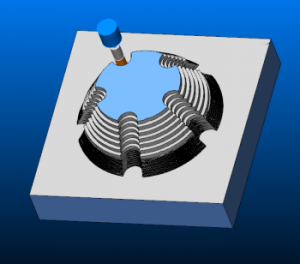 CAD-CAM Software Advanced Roughing and Step Reduction
CAD-CAM Software Advanced Roughing and Step Reduction
One of the challenges that CNC shops face when it comes to 3 Axis milling is in the area of complex roughing or “Z-Level” roughing. This is also known as “waterline” or “Core milling” in the world of CAD-CAM software part programming. When leaving the world of 2D milling and entering the world of complex 3D surface machining, a new set of particular skills are required for generating an accurate and efficient NC program.
Without CAD-CAM software, these types of CNC jobs can be nearly impossible to cut due to the math calculations involved. Fortunately, modern CNC software products provide a variety of 3D machining capabilities that continue to give programmers faster, smarter and easier solutions to machining difficult 3D parts. Z-Level Roughing operations are generally used as a way to remove the majority of the material necessary to perform a semi-finish roughing operation with a smaller tool that has a reduced step over and Z step-down during cutting. The advent of “Step Reduction” technology brings a faster and far more efficient method of machining that helps speed up cycle times and produces improved part finishes.
Step Reduction Using Intermediate Steps
CAD-CAM step reduction technology is used to reduce the large stair type effect that is created as the roughing tool machines down the part contour at each Z axis cutting level. This large stair step effect makes semi-finishing more difficult and even harder on cutting tools. The solution is to add a secondary action to the process that starts at the bottom of the Z-Level roughing stage and comes back up machining intermediate Z-Levels until the tool has reached the top of the part.

The result is a much better finish before semi-finishing has even taken place. This is considered one machining strategy and doesn’t require a tool change. The intermediate steps are controlled by the user and can be as many as required to achieve the required results.




Leave a Reply